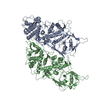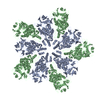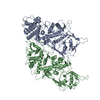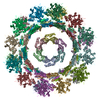+ データを開く
データを開く
- 基本情報
基本情報
| 登録情報 | データベース: PDB / ID: 7lwy | |||||||||||||||||||||||||||||||||
|---|---|---|---|---|---|---|---|---|---|---|---|---|---|---|---|---|---|---|---|---|---|---|---|---|---|---|---|---|---|---|---|---|---|---|
| タイトル | TVV viral capsid protein | |||||||||||||||||||||||||||||||||
 要素 要素 | Capsid protein | |||||||||||||||||||||||||||||||||
 キーワード キーワード | VIRAL PROTEIN / Capsid | |||||||||||||||||||||||||||||||||
| 機能・相同性 | Capsid protein 機能・相同性情報 機能・相同性情報 | |||||||||||||||||||||||||||||||||
| 生物種 |  Trichomonas vaginalis virus 2 (ウイルス) Trichomonas vaginalis virus 2 (ウイルス) | |||||||||||||||||||||||||||||||||
| 手法 | 電子顕微鏡法 / 単粒子再構成法 / クライオ電子顕微鏡法 / 解像度: 4 Å | |||||||||||||||||||||||||||||||||
 データ登録者 データ登録者 | Zhou, Z.H. / Stevens, A.W. / Cui, Y.X. / Johnson, P.J. / Muratore, K.A. | |||||||||||||||||||||||||||||||||
| 資金援助 |  米国, 10件 米国, 10件
| |||||||||||||||||||||||||||||||||
 引用 引用 |  ジャーナル: mBio / 年: 2021 ジャーナル: mBio / 年: 2021タイトル: Atomic Structure of the Trichomonas vaginalis Double-Stranded RNA Virus 2. 著者: Alexander Stevens / Katherine Muratore / Yanxiang Cui / Patricia J Johnson / Z Hong Zhou /  要旨: , the causative pathogen for the most common nonviral sexually transmitted infection worldwide, is itself frequently infected with one or more of the four types of small double-stranded RNA (dsRNA) ..., the causative pathogen for the most common nonviral sexually transmitted infection worldwide, is itself frequently infected with one or more of the four types of small double-stranded RNA (dsRNA) viruses (TVV1 to 4, genus , family ). Each TVV encloses a nonsegmented genome within a single-layered capsid and replicates entirely intracellularly, like many dsRNA viruses, and unlike those in the family. Here, we have determined the structure of TVV2 by cryo-electron microscopy (cryoEM) at 3.6 Å resolution and derived an atomic model of its capsid. TVV2 has an icosahedral, T = 2*, capsid comprised of 60 copies of the icosahedral asymmetric unit (a dimer of the two capsid shell protein [CSP] conformers, CSP-A and CSP-B), typical of icosahedral dsRNA virus capsids. However, unlike the robust CSP-interlocking interactions such as the use of auxiliary "clamping" proteins among , only lateral CSP interactions are observed in TVV2, consistent with an assembly strategy optimized for TVVs' intracellular-only replication cycles within their protozoan host. The atomic model reveals both a mostly negatively charged capsid interior, which is conducive to movement of the loosely packed genome, and channels at the 5-fold vertices, which we suggest as routes of mRNA release during transcription. Structural comparison of TVV2 to the L-A virus reveals a conserved helix-rich fold within the CSP and putative guanylyltransferase domain along the capsid exterior, suggesting conserved mRNA maintenance strategies among This first atomic structure of a TVV provides a framework to guide future biochemical investigations into the interplay between and its viruses. viruses (TVVs) are double-stranded RNA (dsRNA) viruses that cohabitate in , the causative pathogen of trichomoniasis, the most common nonviral sexually transmitted disease worldwide. Featuring an unsegmented dsRNA genome encoding a single capsid shell protein (CSP), TVVs contrast with multisegmented dsRNA viruses, such as the diarrhea-causing rotavirus, whose larger genome is split into 10 dsRNA segments encoding 5 unique capsid proteins. To determine how TVVs incorporate the requisite functionalities for viral replication into their limited proteome, we derived the atomic model of TVV2, a first for TVVs. Our results reveal the intersubunit interactions driving CSP association for capsid assembly and the properties that govern organization and maintenance of the viral genome. Structural comparison between TVV2 capsids and those of distantly related dsRNA viruses indicates conserved strategies of nascent RNA release and a putative viral guanylyltransferase domain implicated in the cytoplasmic maintenance of viral messenger and genomic RNA. | |||||||||||||||||||||||||||||||||
| 履歴 |
|
- 構造の表示
構造の表示
| ムービー |
 ムービービューア ムービービューア |
|---|---|
| 構造ビューア | 分子:  Molmil Molmil Jmol/JSmol Jmol/JSmol |
- ダウンロードとリンク
ダウンロードとリンク
- ダウンロード
ダウンロード
| PDBx/mmCIF形式 |  7lwy.cif.gz 7lwy.cif.gz | 428.2 KB | 表示 |  PDBx/mmCIF形式 PDBx/mmCIF形式 |
|---|---|---|---|---|
| PDB形式 |  pdb7lwy.ent.gz pdb7lwy.ent.gz | 351.2 KB | 表示 |  PDB形式 PDB形式 |
| PDBx/mmJSON形式 |  7lwy.json.gz 7lwy.json.gz | ツリー表示 |  PDBx/mmJSON形式 PDBx/mmJSON形式 | |
| その他 |  その他のダウンロード その他のダウンロード |
-検証レポート
| 文書・要旨 |  7lwy_validation.pdf.gz 7lwy_validation.pdf.gz | 1 MB | 表示 |  wwPDB検証レポート wwPDB検証レポート |
|---|---|---|---|---|
| 文書・詳細版 |  7lwy_full_validation.pdf.gz 7lwy_full_validation.pdf.gz | 1.1 MB | 表示 | |
| XML形式データ |  7lwy_validation.xml.gz 7lwy_validation.xml.gz | 40.8 KB | 表示 | |
| CIF形式データ |  7lwy_validation.cif.gz 7lwy_validation.cif.gz | 61 KB | 表示 | |
| アーカイブディレクトリ |  https://data.pdbj.org/pub/pdb/validation_reports/lw/7lwy https://data.pdbj.org/pub/pdb/validation_reports/lw/7lwy ftp://data.pdbj.org/pub/pdb/validation_reports/lw/7lwy ftp://data.pdbj.org/pub/pdb/validation_reports/lw/7lwy | HTTPS FTP |
-関連構造データ
- リンク
リンク
- 集合体
集合体
| 登録構造単位 | 
|
|---|---|
| 1 | x 5
|
| 2 |
|
| 3 | 
|
| 対称性 | 点対称性: (シェーンフリース記号: C5 (5回回転対称)) |
- 要素
要素
| #1: タンパク質 | 分子量: 74037.117 Da / 分子数: 2 / 由来タイプ: 天然 由来: (天然)  Trichomonas vaginalis virus 2 (ウイルス) Trichomonas vaginalis virus 2 (ウイルス)参照: UniProt: Q9JE95 |
|---|
-実験情報
-実験
| 実験 | 手法: 電子顕微鏡法 |
|---|---|
| EM実験 | 試料の集合状態: PARTICLE / 3次元再構成法: 単粒子再構成法 |
- 試料調製
試料調製
| 構成要素 | 名称: Trichomonas vaginalis virus 2 / タイプ: VIRUS 詳細: Virus particles isolated from lysed trichomonas vaginalis Entity ID: all / 由来: NATURAL | ||||||||||||||||||||||||||||||
|---|---|---|---|---|---|---|---|---|---|---|---|---|---|---|---|---|---|---|---|---|---|---|---|---|---|---|---|---|---|---|---|
| 分子量 | 値: 9.40 MDa / 実験値: NO | ||||||||||||||||||||||||||||||
| 由来(天然) | 生物種:  Trichomonas vaginalis virus 2 (ウイルス) / 株: 2 Trichomonas vaginalis virus 2 (ウイルス) / 株: 2 | ||||||||||||||||||||||||||||||
| ウイルスについての詳細 | 中空か: NO / エンベロープを持つか: NO / 単離: STRAIN / タイプ: VIRION | ||||||||||||||||||||||||||||||
| 天然宿主 | 生物種: Trichomonas vaginalis G3 / 株: G3 | ||||||||||||||||||||||||||||||
| ウイルス殻 | 名称: Capsid / 直径: 430 nm / 三角数 (T数): 1 | ||||||||||||||||||||||||||||||
| 緩衝液 | pH: 7.4 詳細: Sterile Solution was prepared fresh to prevent contamination. | ||||||||||||||||||||||||||||||
| 緩衝液成分 |
| ||||||||||||||||||||||||||||||
| 試料 | 包埋: NO / シャドウイング: NO / 染色: NO / 凍結: YES | ||||||||||||||||||||||||||||||
| 試料支持 | グリッドのタイプ: PELCO Ultrathin Carbon with Lacey Carbon | ||||||||||||||||||||||||||||||
| 急速凍結 | 凍結剤: ETHANE / 詳細: The grids were manually plunged into liquid ethane. |
- 電子顕微鏡撮影
電子顕微鏡撮影
| 実験機器 |  モデル: Titan Krios / 画像提供: FEI Company |
|---|---|
| 顕微鏡 | モデル: TFS KRIOS |
| 電子銃 | 電子線源:  FIELD EMISSION GUN / 加速電圧: 300 kV / 照射モード: FLOOD BEAM FIELD EMISSION GUN / 加速電圧: 300 kV / 照射モード: FLOOD BEAM |
| 電子レンズ | モード: BRIGHT FIELD / 倍率(公称値): 105000 X / 最大 デフォーカス(公称値): 3000 nm / 最小 デフォーカス(公称値): 800 nm / Cs: 2.7 mm / C2レンズ絞り径: 50 µm / アライメント法: COMA FREE |
| 試料ホルダ | 凍結剤: NITROGEN 試料ホルダーモデル: FEI TITAN KRIOS AUTOGRID HOLDER |
| 撮影 | 平均露光時間: 0.2 sec. / 電子線照射量: 17 e/Å2 / 検出モード: SUPER-RESOLUTION フィルム・検出器のモデル: GATAN K2 SUMMIT (4k x 4k) 実像数: 2177 |
| 電子光学装置 | エネルギーフィルター名称: GIF Quantum LS / エネルギーフィルタースリット幅: 20 eV |
| 画像スキャン | 横: 3838 / 縦: 3710 / 動画フレーム数/画像: 30 |
- 解析
解析
| EMソフトウェア |
| ||||||||||||||||||||||||||||||||||||
|---|---|---|---|---|---|---|---|---|---|---|---|---|---|---|---|---|---|---|---|---|---|---|---|---|---|---|---|---|---|---|---|---|---|---|---|---|---|
| CTF補正 | タイプ: PHASE FLIPPING AND AMPLITUDE CORRECTION | ||||||||||||||||||||||||||||||||||||
| 粒子像の選択 | 選択した粒子像数: 5076 | ||||||||||||||||||||||||||||||||||||
| 対称性 | 点対称性: C5 (5回回転対称) | ||||||||||||||||||||||||||||||||||||
| 3次元再構成 | 解像度: 4 Å / 解像度の算出法: FSC 0.143 CUT-OFF / 粒子像の数: 29916 / クラス平均像の数: 1 / 対称性のタイプ: POINT | ||||||||||||||||||||||||||||||||||||
| 原子モデル構築 | プロトコル: AB INITIO MODEL / 空間: REAL 詳細: Model was manually built into EM map using Coot, then PHENIX was used for real-space refinement |
 ムービー
ムービー コントローラー
コントローラー











 PDBj
PDBj